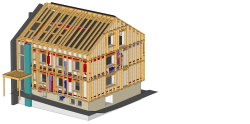Renovation database to boost energy efficiency across the EU
The EU-funded INSPIRE project successfully tackled the issue of high-energy consumption in buildings by developing a series of renovation packages suitable for different climates, aiming to reduce the primary energy consumption of a building to lower than 50 kWh/m2/year. Thanks to the project, engineers, architects and decision makers now have access to an online database of these renovation solutions, which are suitable for a variety of situations. Retrofitting is usually a complex and expensive procedure, and involves discomfort and inconvenience for residents. This is why the project concentrated on achieving a high degree of prefabrication capable of overcoming technical barriers and achieving acceptance from construction professionals and investors. Indeed, INSPIRE carried out simulations that trialled different combinations of insulation, windows, ventilation and heating and cooling technologies. These were applied to different building types in order to understand which combinations work best in terms of energy performance and environmental and financial cost. ‘More than 200 000 combinations were trialled,’ explains Fedrizzi. ‘The comprehensive nature of our database means that professionals do not need to go through calculations to get pre-design indications on how to retrofit their buildings – this has already been done for them.’ The analysis took into account building age, structural characteristics and ownership to ensure that a broad range of building types were included. ‘A key success of the project was in moving the focus of renovation technologies from the construction site to the fabrication process, resulting in so-called “Industrialised Kits” with multiple functionalities,’ explains project coordinator Roberto Fedrizzi from EURAC in Italy. ‘We also sought to move installation and operational complexity away from homes and offices as much as possible. The idea is that these kits are industrialised products integrating different retrofitting components into complete prefabricated solutions.’ Components include HVAC systems, lighting and shading systems, pipe and air-ducts and energy generation systems. What makes this project different is that it took a holistic approach to renovation and targeted energy savings in all possible aspects of building renovation. Two demo sites were renovated, one in Ludwigsburg, Germany and one in Madrid, Spain, in order to validate retrofit approaches and to assess the technologies’ performance. The same sites were also used to evaluate possible technical and non-technical barriers to the market uptake of the solutions: planners, installers and final users where deeply involved in the planning process to verify their readiness accepting, adopting and using the solutions proposed. ‘In particular, the prefabricated wooden façade elements involving insulation, new windows and active systems such as ventilation units ducts proved to be very effective during the installation phase,’ says Fedrizzi. ‘We envisage that some kits will be further demonstrated within new Horizon 2020 innovation projects already started, while others will be trialled in real-life buildings. Once the integration of active components is fully standardised and assessed on the large scale, and the business model will be fine-tuned, the solution will be ready for the mass market’. The INSPIRE project was completed in September 2016.
Keywords
Renovation database, energy efficiency



